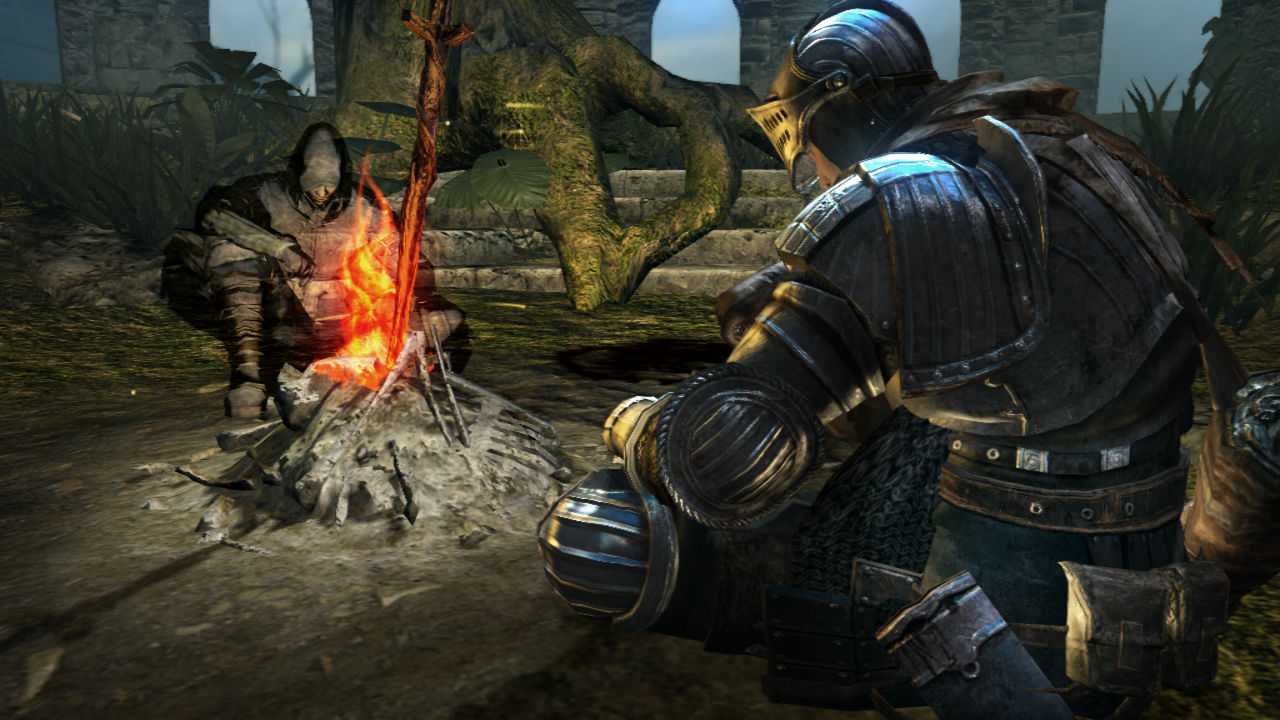Lordran is a land full of death, decay, and despair. The Dark Souls series (or Soulsborne games as a collective) are well-known by now for their unforgiving difficulty and YOU DIED screens. While it’s been over ten years since FromSoftware’s first entry in the franchise, Demon’s Souls, I have spent all that time actively avoiding playing any of the games. Until now.
I was a fresh-faced and innocent 20-year-old when Demon’s Souls first released in my homeland of England. I bought it; I still have the deluxe box along with the hardback artbook and soundtrack it shipped with. I think I cleared the first level and decided I was not cut out for such a nerve-testing experience. The exact same thing happened when Dark Souls was released two years later. “This time,” I thought to myself, trying to instill a false sense of confidence in my quaking heart, “This time, I will finish the game.” Spoiler alert: I didn’t. I’m not sure if I even killed the boss in the first proper level. There’s a saying that goes, “fool me once, shame on you; fool me twice, shame on me.” I took that to heart all those years ago, and never again did I touch a Souls game until very recently.
More recently, I discovered the joy of watching other people play games on YouTube. My reasons ranged from “I’m too scared to play this game” for survival horror games to “I don’t think I’d enjoy playing this game myself, but I’d still like to watch someone else play it.” I am not ashamed to admit that many series interest me, but the games don’t fit my personal playing preferences. These include titles like the Resident Evil series and the Walking Dead games. All excellent titles in their own right, but I am mostly a puritan for RPGs.
During this “experimental” phase, I found Gab Smolders‘ playlist of her 2019 playthrough of Bloodborne, a game I’d obviously heard of but lacked the required points in Constitution (or Wisdom?) to delve into myself. Gab, real name Evelien, presented her playthrough in a very accessible way for newcomers to Soulsborne games: knowing how to play the game herself and what to expect while keeping her playthrough informative yet spoiler-free.
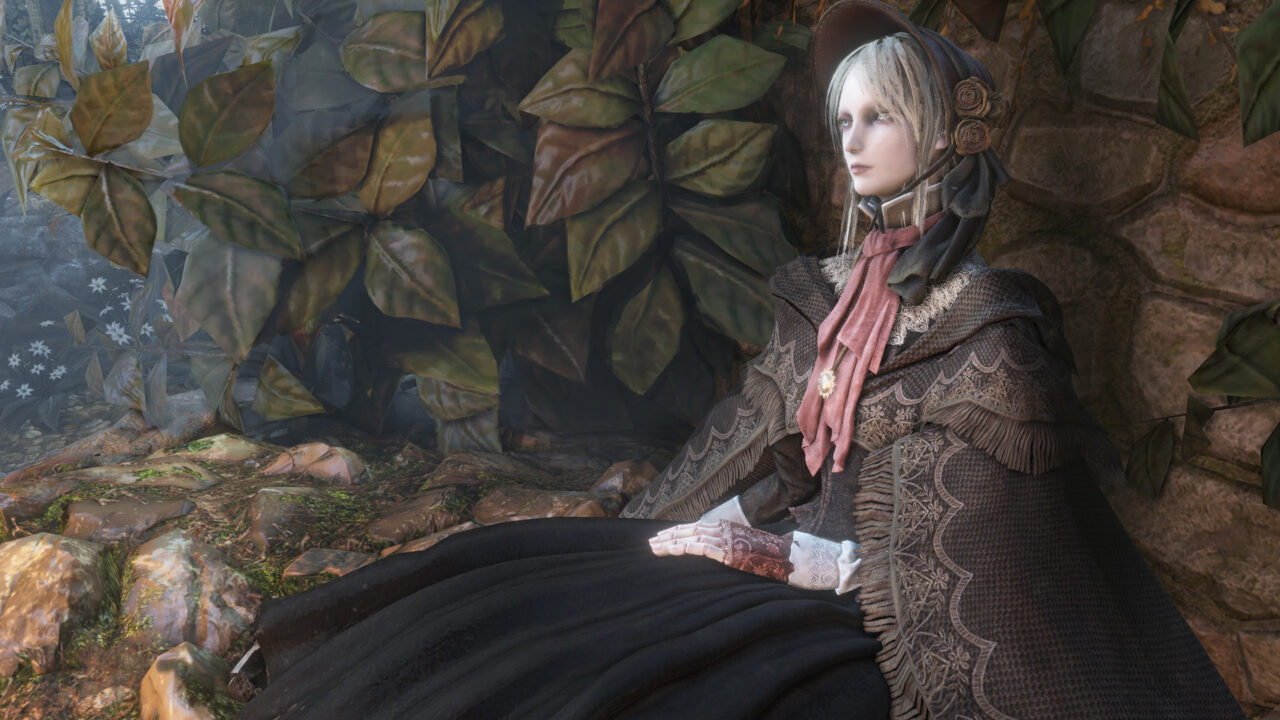
Watching Evelien play Bloodborne made me realise something: I’d never taken the time to learn the core gameplay mechanics back when I dipped my delicate toes into the Souls waters. These games heavily rely on the balance from their fine-tuned mechanics to establish their learning curve and sense of satisfaction. However, I still had no intention of playing Bloodborne myself, nor any of the Souls games. I may have caved to an impulse-buy if I was more of a PS4 gamer, but Bloodborne specifically wasn’t available on any of my favoured platforms. Late in 2020, Evelien started a series playing the newly released Demon’s Souls remake for the PS5. The game looked gorgeous, I lamented the fact I did not have a PS5 to play the game myself, but it was also a convenient excuse to avoid facing my fears for a bit longer.
Another of my favourite YouTubers, John Wolfe, began a playthrough of Bloodborne on his channel early in 2021. Aside from the fact that they are different people, John’s playthrough significantly differed from Evelien’s because he’d only played a small amount of Bloodborne previously, and that had been about five years prior. He’d actually done a similar thing to me with my attempts at Souls games: played up to about the second level and noped out of it. Watching him end up ploughing through the whole game gave me a little spark of hope that I might be brave enough to conquer my fears and achieve the same. And, as if by magic, I had purchased the Dark Souls Trilogy collection for my Series X.
Let’s be clear on one thing here: this timeline is very drawn out. Evelien started her playthrough of Bloodborne in 2019, and John began his in January 2021. I purchased the Dark Souls Trilogy in April of 2021, according to my Amazon order history. Did I play it in April of 2021? No. May? No. June? No. I’ll save us all the time of going through every month of the year by informing you that it took me all the way until December of 2021 to begin playing Dark Souls Remastered. It was actually thanks to Evelien that I ever even put the disc in my console; she began a playthrough of Dark Souls Remastered in late December 2021, and I saw the sign. The White Soapstone Sign summoned me to Lordran. Finally… I began playing.
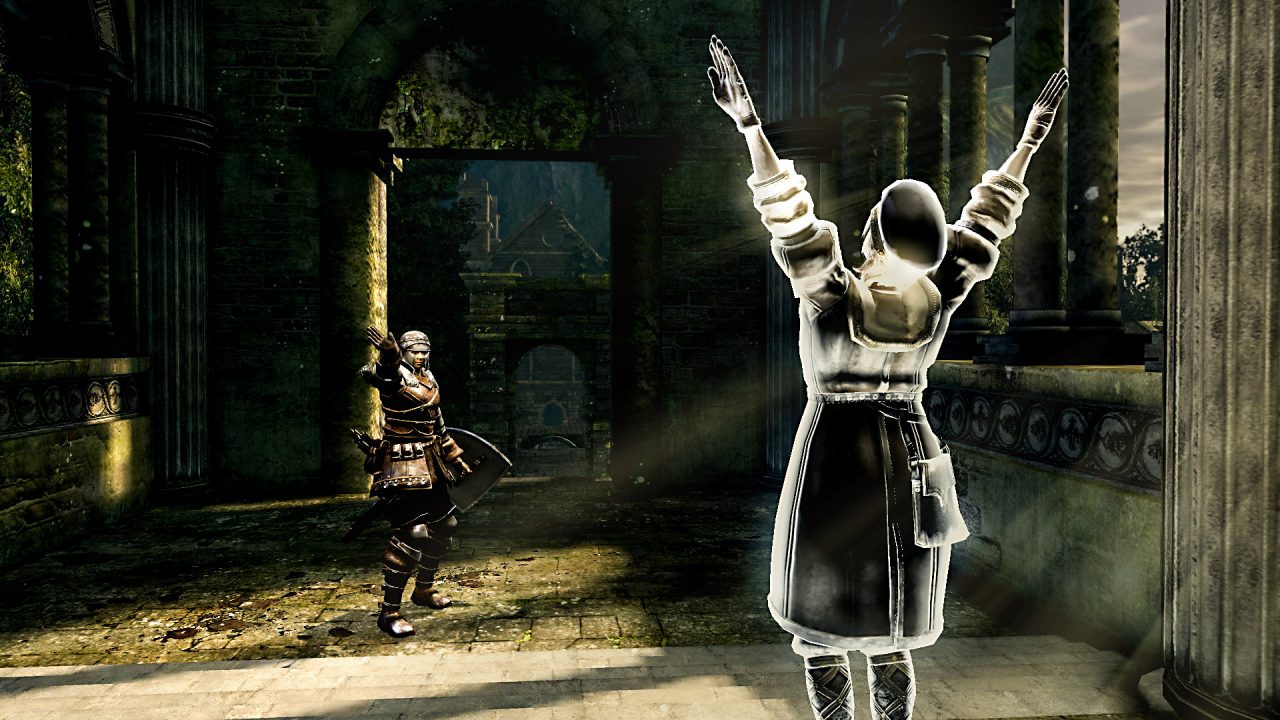
Okay, let’s all take a deep breath. We had 12 years of history to digest before reaching this point, and it was all crucial personal development. It’s quite touching, yet in hindsight it’s definitely not a prerequisite for playing Dark Souls to have done so much inner searching. There’s also no shame for those of us who did need it.
The first objective in Dark Souls may already send shivers down some readers’ spines: character creation. Personally, I am the sort who will customise every little detail to make the perfect character. It’s perhaps a slightly pointless endeavour here because of a lovely feature called Hollowing, in which we revert to a zombie-like form, but it’s nothing a good moisturiser can’t fix. Content with my adorable little cleric dude, I confirmed my choices and prepared to die (that was a throwback to the original Prepare to Die edition, which truly proves how long this has been brewing).
Opening sequences are critically important for setting the tone of things to come. Dark Souls opens with the player character in an Undead Asylum cell with little explanation of how they got there. A corpse drops down from a ceiling hatch, and the short cutscene ends with a knight brooding at us from above. The knight is wearing a full helmet so we don’t see his face, but I just know it’s an ominous expression underneath that visor. The corpse, on the other hand, conveniently holds the key to the cell we are rotting away in, and our freedom is imminent. This section, while simple at first glance, actually reveals a lot of context and foreshadowing. We are locked in the cell, and the instinct would be to escape, but it’s probably much easier to sit tight and wait for oblivion. However, that would be counterproductive to survival, and we must take that first brave step in unlocking our cell door if we want to progress.
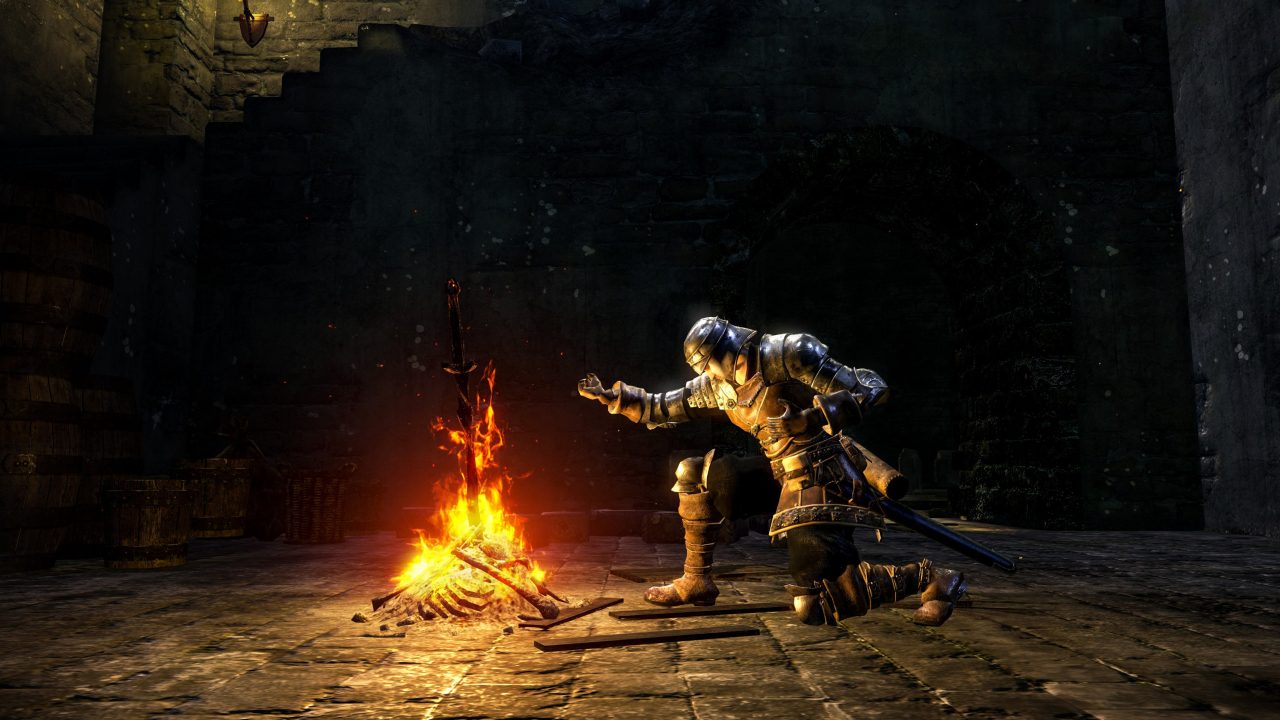
The Undead Asylum is the player’s tutorial area and introduces us to the expected mechanics and gameplay loop. Gameplay hints are left in bloodstained messages on the ground, rather than more conventional ways such as a helpful NPC or illustrated popup. This method of receiving information may become invaluable as the game progresses; part of the online functionality is that players worldwide can leave behind messages to help guide others down the right path. Or… off a cliff and into a downward spiral of rage. Take them with a pinch of salt.
As this article’s purpose is encouraging new players to experience Dark Souls, I won’t spoil anything as far as bosses or what comes next; I truly believe the game is best with as little prior knowledge as possible. What I will say is that every obstacle in this game is designed to be overcome, and though you may die many times to the exact same enemy, you eventually learn how to tackle the situation and emerge victorious. Learning the basic mechanics such as blocking and dodging is integral to progress, and you can try a parry or two if you’re feeling fancy.
The default control scheme is very intuitive, with most of the combat moveset bound to the shoulder buttons. Combat can be very stressful, but the simple controls become second nature quickly and make fights feel engaging and visceral. If there’s one recommendation I’d make, it would be to rebind your jump button. By default, the B/ Circle button is used for dodging, sprinting, and jumping and is perhaps a bit over-utilised. Later games in the series bind your jump action to L3, which removes the risk of accidentally jumping in combat when you want to roll. I didn’t discover this until after my playthrough was over, and I can confidently say it would have saved a few deaths if I’d thought to rebind it earlier.
Your character’s development is entirely in your hands. Character creation has a selection of pre-set starter archetypes, but how you build your attributes is flexible once you start gaining Soul Levels. As someone who cannot parry to (literally) save their life, I opted to build my character around his faithful shield. I’m trying to resist puns here, but I leveled him with the Faith stat as his primary focus, and I never felt like I’d made the wrong decision. Sure, he didn’t hit as hard as perhaps as a Strength or Dexterity-based character might have, but after I found a weapon whose damage scaled based on Faith, I never looked back. A few hours into the game, you can play around with forging your weapon to give it new stats. Doing so adds another level of versatility to the vast weapons roster, as you’ll be able to make many base weapons scale off your Faith or Magic stat. It further diversifies your build options and makes almost any weapon useful, albeit perhaps not for the whole game.
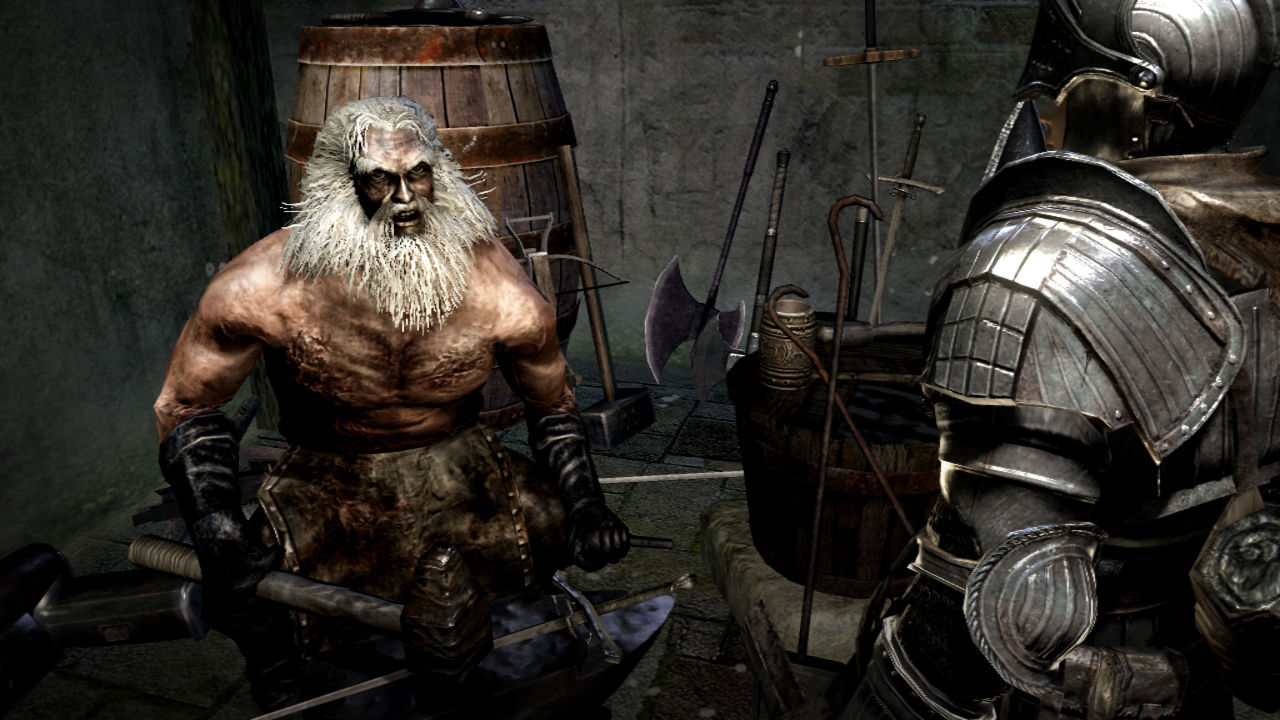
Building the Faith stat also meant I had access to a range of Miracles, Dark Souls’ brand of white magic; being able to cast Heal when my Estus Flask was empty never got old. Homeward was also a worthwhile spell to have, returning me to the last Bonfire I’d rested at and reminding me somewhat of the old World of Warcraft “bubblehearth” escape method. I have a wonderful video capture of me about to be clawed to death by a drake but casting Homeward just as the talons ripped through me and somehow escaping my fate. The game does have its small mercies.
There are many factors to consider while building your character. Perhaps the most important thing is that every piece of equipment you actively equip has a weight to it, and reaching different thresholds of your character’s weight limit affects your speed. Endurance is the governing stat for both the weight limit and your character’s Stamina stat—the green bar in the top left corner of the screen—which is consumed by actions such as sprinting, attacking, and blocking. Therefore, while you might want to equip that huge hammer alongside a set of knightly armour, you also need the Endurance to accommodate such heavy gear. Alongside this, most gear also has minimum stat requirements. You can feasibly acquire some endgame gear fairly early on in a playthrough, but it’s next to useless unless you have the stat requirements to equip it. This might sound tedious, but it’s an excellent way to keep yourself motivated as you inch your stats ever closer to being able to equip your dream gear.
My main piece of advice for anyone looking to play a Soulsborne game for the first time, not just Dark Souls Remastered, is to take it at your own pace. If a specific area is too frustrating, then try returning to it another time. There’s a lot to learn in these games, and it’s easy to be intimidated away from making any progress, but the sense of accomplishment gained from finally getting it right is unique to the series. Do not go into these games expecting to be able to hack your way to victory; it just doesn’t work like that. The combat is methodical and every enemy is equally capable of destroying you as you are it. Things get more manageable as your reflexes improve and you learn enemy patterns, only for the game to throw you a curveball around the very next corner. When I said, “take it at your own pace,” what I really meant was “walk around that corner slowly and keep your shield raised.”
The upcoming release of Elden Ring influenced my timing to finally conclude Baby’s First Dark Souls Playthrough, and I am genuinely proud of myself for the accomplishment. It’s a strange feeling to have known of the series for so long, even played its first two incarnations, yet to never have understood what the games are about. It’s not just about dying nine times to the same boss or losing a big chunk of souls to an ill-timed roll off a bridge. I’d argue it’s somewhat shameful that it’s those moments that have become so prevalent in our shared knowledge of the Soulsborne games. There’s so much more to them. They are feats of art and sound design, perfectly crafted gameplay mechanics, deep lore, and a value to your belongings that makes you appreciate everything you use. The path may be fraught with unseen dangers, but none of them are insurmountable. It all comes from you.

